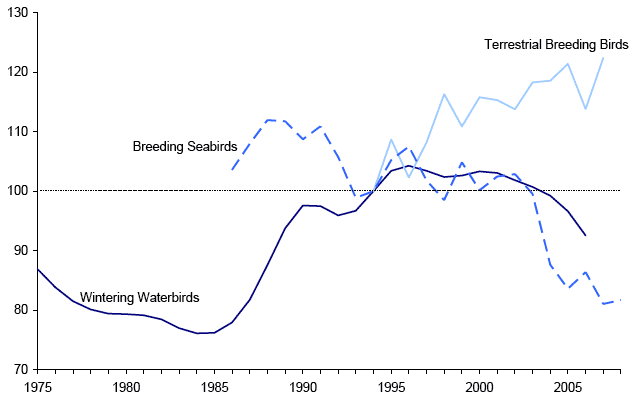Key Scottish Environment Statistics 2009
Annual publication containing summary of key statistics on environmental trends in Scotland
Biodiversity
Status of Wild Bird Populations: 1975-2008
Index (1994 = 100)

Index (1994=100)
1975 |
1986 |
1994 |
2000 |
2005 |
2006 |
2007 |
2008 |
|
|---|---|---|---|---|---|---|---|---|
Wintering Waterbirds 9 |
87 |
78 |
100 |
103 |
97 |
93 |
- |
- |
Terrestrial Breeding Birds |
100 |
116 |
121 |
114 |
122 |
- |
||
Breeding Seabirds |
104 |
100 |
100 |
84 |
86 |
81 |
82 |
Bird populations are relatively well studied and can provide an indication of the changing biodiversity of Scotland's habitats.
The number of wintering waterbirds rose between the mid 1980s and mid 1990s, reaching a peak in 1996, since then there has been a steady decline. Seabird numbers have been in decline since 1991 and continued to decline until 2008. While the number of terrestrial breeding birds has risen since 1994, this follows declines, particularly in farmland birds, in earlier years.
Naturally occurring birds and their habitats are protected under the Nature Conservation Scotland Act 2004 and the EC Birds Directive (79/409/EEC and amendments). Following the publication of the UK Biodiversity Action Plan (1994), species action plans have been developed for 26 particularly vulnerable species of birds, 19 of which occur in Scotland.
The Scottish Government has established a National Indicator to increase the index of abundance of terrestrial breeding birds in Scotland against a 2006 base year. This is used as a proxy measure of biodiversity, as biodiversity cannot be measured by a single indicator.
Source: British Trust For Ornithology/ Joint Nature Conservation Committee/ Wildfowl And Wetlands Trust/ Shetland Oil Terminal Environmental Advisory Group
There is a problem
Thanks for your feedback